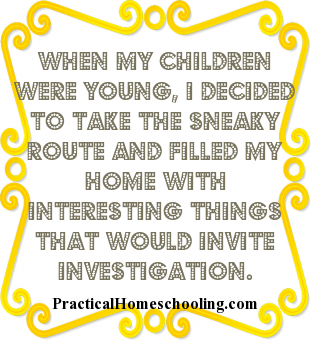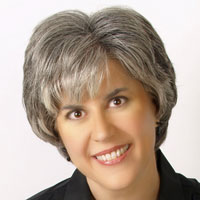10 Ways to Prepare Your Home for Joyful Learning
By Jeannette Webb
Printed in Practical Homeschooling #96, 2010.
 Sacrifice a little neatness and make your home a place where kids love to learn
Sacrifice a little neatness and make your home a place where kids love to learn

| 
|
Traditional educators would be horrified at my methods. I hate
textbooks, rigid routines, and checklists. However, I’m not a
laid-back kind of a gal. My family will verify that I’m definitely a
Type A personality, but with one degree in child development and years
as a Youth Development Specialist, I know that truly embracing
knowledge is a choice made by my child, not a demand I can place on
him.
 Therefore, when my children were young, I decided to take the sneaky
route and filled my home with interesting things that would invite
investigation.
Therefore, when my children were young, I decided to take the sneaky
route and filled my home with interesting things that would invite
investigation.
This wasn’t easy for me. I’m a tidy person and prefer to have neatly
labeled boxes (with lids) lining shelves and everything in its place
in an impeccably decorated home, but I had to step out of my comfort
zone and settle for a bit of a mess in order to invite discovery.
Here are some ways I set up learning opportunities. They weren’t on
the school assignment sheet. There were no requirements that the
children participate. I didn’t feel like a failure when an opportunity
was passed up.
The Art Studio
Our schoolroom had a walk-in closet lined with shelves. On the lowest
shelves, within reach of little hands, I filled clear containers with
every kind of craft item imaginable: pipe cleaners, polymer clay,
sculpting clay, construction paper, craft foam, cardboard, paint,
sketch pads, sketching pencils, colored pencils, crayons, fabric,
glue, yarn, fabric swatches, knitting needles and crochet hooks,
embroidery thread, etc, etc. My daughter loved working with her hands
and learned to crochet at the tender age of five. She spent hours
happily creating projects. My son never ventured near the closet. He
preferred the workbench his grandfather built for him on the back
porch. There he hammered nails into wood and glued wood scraps
together and created more manly things.
The Science Lab
While my daughter lost track of time in the craft closet, my son spent
hours in his “lab.” His affinity for science asserted itself extremely
early and his burning questions occupied hours a day. He used a
magnifying glass as a toddler to examine things. As soon as he had the
fine motor skills to handle it, we purchased two microscopes: one with
a platform for three-dimensional objects (rocks, butterflies, etc.)
and one for use with prepared slides. They were always out and ready
to reveal a wonderful microscopic world. He had test tubes and
butterfly nets and batteries and wires. I had to give up my work area
on the back porch as his experiments and equipment took up every
square inch and filled every drawer, but a man must not be kept from
exploring the mysteries of the universe.
The World at our Fingertips
While most of our walls were lined with bookcases, we kept one wall
free in my son’s room to place a large world map and a U. S. map at
his eye level. There was a globe nearby for perspective. Anytime we
were reading about a particular place, we would stop and find it on
the map. Several times throughout the years, the kids made their own
maps as part of a particular study. I have a feeling that my son spent
a great deal of time with these maps on his own, because today his
knowledge of countries and geographical locations is astounding. But I
shouldn’t be surprised. He looked at it every day and the countries on
our planet just became a part of his world.
Trapped in the Bathroom
Years ago, a new homeschool acquaintance emerged from our bathroom on
her first visit to our home shaking with laughter. She couldn’t
believe that I actually hung posters on the wall directly opposite
the, um, throne.
Well. What else are they going to do while they are sitting there??? I
thought they just as well be learning something new or thinking about
something interesting.
So through the years there were bathroom posters of cloud formations,
U.S. Presidents, Oklahoma trees, fish, wildlife and other various
topics. I figured that if efficiency expert Frank Gilbreth (of Cheaper
by the Dozen fame) made his kids listen to French lessons while they
bathed, surely I should make good use of bathroom time, too.
The Museum of Natural History
Some people collect priceless art. My kids collected the work of the
Master Artist and decorated my kitchen bar with it. Snake skins, bird
eggs, abandoned cicada shells, pretty rocks, and bird nests (when the
birds were through with them). Sometimes I had to avert my eyes while
fixing dinner, but they loved their treasures and wanted to learn more
about them. They would bring a bird book, climb up on the stool, and
compare their nest with those in the book or a find a book about
snakes and figure out why they shed their skins.
The Zoo
My kids were transfixed with the ant farm and the fish aquarium inside
the house and the hummingbird feeder and birdbath they could watch
from the window. So much activity! They had a ball watching nature in
a created environment that was easily accessible to them. Through the
years we had bird feeders and squirrel feeders and planted bushes that
attracted butterflies.
We were also fortunate to live in the country, so had access to a wide
variety of beasts and birds. We watched the wildlife on the canyon rim
through binoculars (which were always by the window to be grabbed
quickly) and traced their tracks in the mud. We found their dens and
watched their broods of babies from a distance.
The Garden
We planted fruit trees, blackberry bushes, strawberries, tomatoes, and
green beans. Each child had their own little garden space where they
could plant what they wanted. At an early age they had
responsibilities to weed and water, harvest and preserve. They learned
about plants firsthand and were so proud to serve food that they had
raised and prepared themselves.
The Art Museum
We had a continually rotating art print on a low table where the kids
could see it as they galloped by. We would take it down and talk about
it once a week for a few minutes. Often I would rotate three or four
prints from the same artist over a month’s time, so the kids could
learn to identify the style and subject matter of particular painters.
If we visited an art museum, I would tell them to pick out their
favorite picture and we would try to find a postcard of it to display.
My daughter recalls paying careful attention throughout the museum
because she wanted to find her favorite painting and take it home.
The Concert Hall
There is a lot of maintenance that has to happen to keep a home
functional. Meals need to be prepared and the house needs to be
cleaned.
We always did these things together (the shortest kid dusting the
baseboards, the taller kid dusting everything in his reach, and Mom
handling the high stuff). We fixed meals together, each having their
own job. Usually I had classical music going while we worked.
Sometimes they asked what the piece was, but usually they just
enjoyed.
Today my daughter still loves the music she grew up with while she
worked: Vivaldi’s The Four Seasons, Bach’s Brandenburg Concertos, and
Handel’s Water Music.
The Spontaneous Unit Study
By inviting my children to discover the world for themselves, I
assumed the responsibility for being ready to deal with their
questions when they popped up. A teachable moment is precious, and I
always tried to make the most of it.
While our home is loaded with books, I did rotate books in and out so
there would always be something fresh. I also held certain types of
books in reserve in my unit study boxes. Over the course of the year I
would find treasures to fill my boxes: books from library sales or
homeschool conventions, science kits or themed art projects from
museum stores, posters from national parks, documentaries, games, etc.
I’ll give you some examples of how this system worked.
One day my children discovered a badger den, so we pulled out the box
on mammals, which contained wonderful books about various types of
animals, their homes, and their habitats. There were posters
identifying different Oklahoma wildlife (which went up in the
bathroom). We started the book The Wind in the Willows.
After visiting Mount St. Helens National Volcanic Monument, I pulled
out my volcano box. There were books about how volcanoes worked, a
picture book about the buried city of Pompeii, some ideas torn from a
magazine that featured experiments that replicated a volcano, a
National Geographic video, and a poster identifying all the volcanic
hot spots around the world. We set to work understanding all we had
just experienced.
My family emigrated from Sweden three generations back and wound up in
Oklahoma making the Land Run. My Swedish box contained a book of
native crafts for children, Swedish recipes, maps, children’s books
about immigration, Ellis Island, and adjusting to a new country. When
our little family suddenly moved from the farm to the heart of Dallas,
the Swedish immigration box went too. While we were adjusting to a
strange new world, we studied how other displaced persons felt, ate
the food that my great-grandmother would have had in Sweden, made dala
horses, studied Swedish customs, read her letters, and tried to let
her courage infuse our days.
A Place of Joy
While all this may sound like a random jumble of stuff, it was really
a very calm existence filled with little discoveries that were pursued
and thoughts that were discussed. Some of our school subjects were
very sequential, but each day was rounded out with little surprises
that created a joyful learning environment. Our lives had few
extracurricular activities, so there was plenty of time to follow up
on things of interest.
My husband and I are curious, industrious people and we wanted to
cultivate that in our small children. It was a lot of work for us to
set up situations that allowed them to “stumble upon” something
exciting, but I think it was worth it.
As young adults, our kids have been wildly successful academically,
but it has not been from following the grinding checklist experienced
by many of their peers. Their success has been the result of their
curiosity continually propelling them into new territory. As my
daughter recently remarked, “I still love to learn. That is a fairly
rare thing, even on a campus like Princeton.”